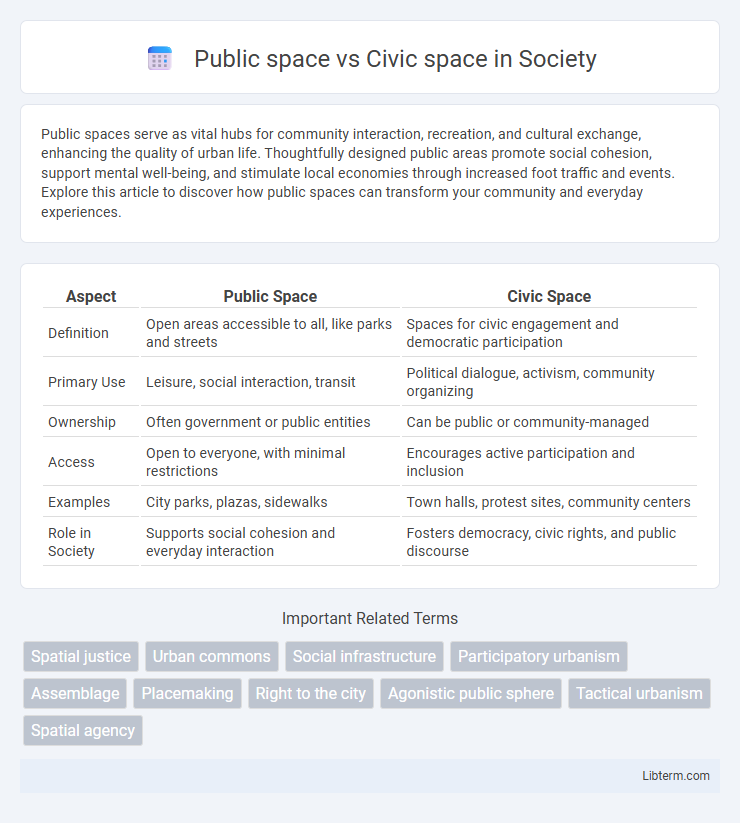Public spaces serve as vital hubs for community interaction, recreation, and cultural exchange, enhancing the quality of urban life. Thoughtfully designed public areas promote social cohesion, support mental well-being, and stimulate local economies through increased foot traffic and events. Explore this article to discover how public spaces can transform your community and everyday experiences.
Table of Comparison
| Aspect | Public Space | Civic Space |
|---|---|---|
| Definition | Open areas accessible to all, like parks and streets | Spaces for civic engagement and democratic participation |
| Primary Use | Leisure, social interaction, transit | Political dialogue, activism, community organizing |
| Ownership | Often government or public entities | Can be public or community-managed |
| Access | Open to everyone, with minimal restrictions | Encourages active participation and inclusion |
| Examples | City parks, plazas, sidewalks | Town halls, protest sites, community centers |
| Role in Society | Supports social cohesion and everyday interaction | Fosters democracy, civic rights, and public discourse |
Defining Public Space and Civic Space
Public space refers to areas like parks, streets, and plazas accessible to all individuals without restriction, serving recreational, social, and economic functions. Civic space encompasses public spaces specifically designed or regulated to support political expression, citizen engagement, and democratic activities. Defining distinctions highlight that while all civic spaces are public, not all public spaces function as civic spaces due to differences in purpose, governance, and user interactions.
Historical Evolution of Urban Spaces
Public spaces emerged as open areas accessible to all, evolving from ancient forums and agoras that facilitated trade and social interaction. Civic spaces developed later, reflecting organized political and community activities in urban settings, such as town halls and plazas designed for governance and public discourse. The historical evolution of urban spaces illustrates a shift from multifunctional social hubs to specialized environments fostering civic engagement and democratic participation.
Key Characteristics of Public Spaces
Public spaces are open areas such as parks, plazas, and streets accessible to all, fostering social interaction, recreation, and community engagement. These spaces prioritize inclusivity, safety, and accessibility, often managed by local governments to ensure maintenance and public use. Key characteristics of public spaces include openness, neutrality, and multifunctionality, supporting diverse activities and serving as essential venues for everyday social life.
Distinct Features of Civic Spaces
Civic spaces are specifically designed for public engagement, fostering democratic participation, dialogue, and community decision-making, unlike general public spaces that primarily serve recreational or social purposes. These spaces often include features such as forums, town halls, and designated protest areas, which encourage active citizen involvement and collective action. Civic spaces emphasize inclusivity, transparency, and accessibility to support governance and civic responsibility.
Functions and Purposes of Each Space
Public spaces serve as open areas accessible to all individuals, primarily functioning as venues for social interaction, recreation, and community gatherings. Civic spaces, often government-owned or institutional, focus on enabling democratic participation, political expression, and public decision-making processes. While public spaces emphasize leisure and informal engagement, civic spaces prioritize structured activities like protests, forums, and official ceremonies.
Governance and Regulation Differences
Public spaces are typically managed by government authorities with a focus on maintaining order, safety, and accessibility through formal regulations and policies. Civic spaces, however, often involve collaborative governance models where community groups and stakeholders actively participate in decision-making, emphasizing inclusivity and democratic engagement. The regulatory frameworks in civic spaces tend to be more flexible, encouraging grassroots initiatives and adaptable uses compared to the top-down control seen in public space governance.
Social Inclusion and Community Engagement
Public spaces like parks and plazas facilitate social inclusion by providing accessible environments for diverse groups to interact freely. Civic spaces, including town halls and community centers, enhance community engagement by enabling organized participation in decision-making processes and democratic dialogues. Both types of spaces are crucial for fostering social cohesion, yet civic spaces prioritize active citizenship while public spaces promote informal social integration.
Challenges Facing Public and Civic Spaces
Public spaces often face challenges such as overcrowding, maintenance issues, and safety concerns, which can limit their accessibility and usability for diverse populations. Civic spaces struggle with political polarization, underfunding, and the need for inclusive design that fosters meaningful community engagement and democratic participation. Both types of spaces require sustainable management and policies that balance social, cultural, and environmental needs to remain vibrant and functional.
The Role of Technology in Shaping Spaces
Technology transforms public spaces by integrating smart sensors, interactive digital displays, and augmented reality, enhancing user engagement and accessibility. Civic spaces leverage technology to facilitate transparent governance, enable real-time citizen participation, and streamline public services. The convergence of IoT, mobile connectivity, and data analytics redefines how communities interact with and influence both public and civic environments.
Future Trends in Urban and Civic Design
Future trends in urban and civic design emphasize the integration of smart technology and sustainable practices to enhance both public and civic spaces. Public spaces are evolving into multifunctional areas that support social interaction, environmental resilience, and digital connectivity, while civic spaces are designed to foster citizen engagement and participatory governance through interactive installations and data-driven platforms. This convergence promotes inclusive, adaptive environments that respond dynamically to community needs and urban challenges.
Public space Infographic

 libterm.com
libterm.com